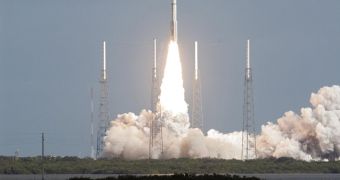The Mars Science Laboratory (MSL) launched successfully from the Cape Canaveral Air Force Station on Saturday, November 26. It was carried to orbit aboard an Atlas V delivery system at 7:02 am EST (1502 GMT), and was then successfully placed in its correct transport orbit.
MSL is scheduled to take several months to reach the Red Planet. Experts estimate that it will make its way onto its surface around August 2012. The event will mark the second time the mission will be in peril. The launch was the other critically-important moment.
NASA was originally supposed to launch this spacecraft about two years ago, but various problems caused it to delay launching MSL until the previous window of opportunity closed. This time, however, everything went on with only a minor hitch.
At first, CCAFS officials cleared the mission for launch on Friday, November 25. However, that was not possible due to an issue investigators discovered in the Atlas V carrier rocket's battery packs. NASA had to delay takeoff by a day, giving its engineers ample time to fix the issue.
This year's launch window between Earth and Mars stays opened between November 25 and December 18, so NASA had until next month to address any glitches that may have arose in the MSL and its rocket, and still launch the vehicles.
“We are very excited about sending the world's most advanced scientific laboratory to Mars,” said NASA Administrator Charles Bolden in a statement. He also mentioned that the spacecraft is scheduled to land inside Gale Crater on August 6, 2012.
“MSL will tell us critical things we need to know about Mars, and while it advances science, we'll be working on the capabilities for a human mission to the Red Planet and to other destinations where we've never been,” he adds.
This area will be scanned for signs of past life, and the rover will then move to analyze its climate history as well. The main goal is to figure out whether the planet was able to support life in any form and at any time.
“The launch vehicle has given us a great injection into our trajectory, and we're on our way to Mars. The spacecraft is in communication, thermally stable and power positive,” NASA Jet Propulsion Laboratory (JPL) MSL project manager Peter Theisinger said after the launch.
MSL has to travel more than 352 million mile (567 million kilometer) before it reaches Mars. Its main cargo is the nuclear-powered rover Curiosity, which is about the size of a Mini Cooper. It is laden with a suite of ten scientific instruments, capable of conducting a wide array of analyses.
“Our first trajectory correction maneuver will be in about two weeks. We'll do instrument checkouts in the next several weeks and continue with thorough preparations for the landing on Mars and operations on the surface,” Theisinger explains.

 14 DAY TRIAL //
14 DAY TRIAL //